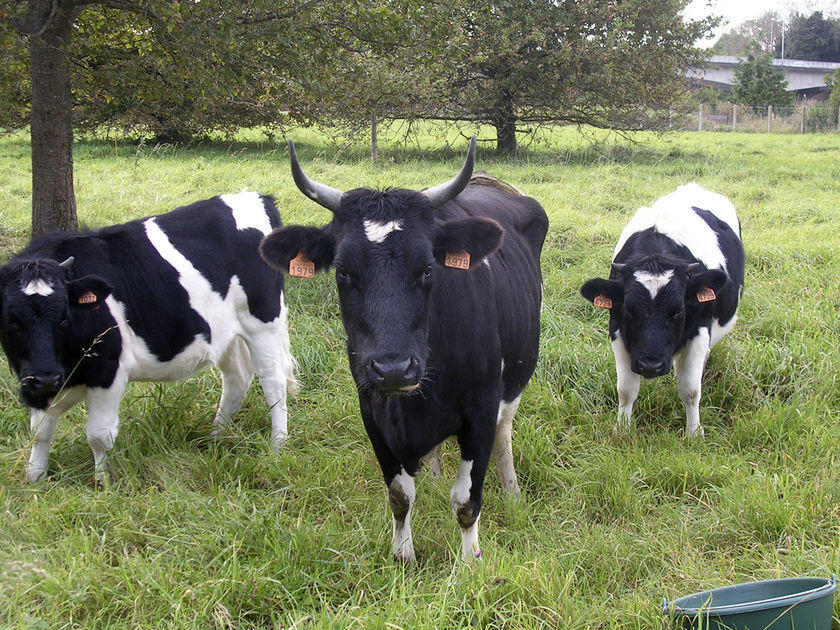Animals in the City
 Animals in the City
Animals in the City
Pastoral management....
The City of Quimper has adopted pastoral management for some of its green spaces. This consists of using animals to maintain the land in a natural fashion. This method avoids the use of pesticides and mechanical and motorised machinery. It offers many advantages: the animals graze not only on the grass, but also on young tree shoots, thereby limiting a proliferation of growth that could suffocate the plot. In addition the animal manure enriches the soil and their hooves churn the earth, contributing to the increase of biodiversity by encouraging re-growth and the appearance of new plant species.
….. By the Bretonne Pie Noir (Breton piebald cow)
Bretonne Pie Noir cows have also been used at Locmaria since 2008. They graze on 2.5 hectares of green space bordering the Odet. The city is thereby participating in the preservation of a species that is part of the Breton heritage. In the 1960’s there were almost 500,000 Bretonne Pie Noir, but 20 years later they had practically disappeared, with only 300 animals still registered. Thanks to a conservation plan and initiatives such as that of Quimper, this small rustic cow, which is well adapted to poor ground, now numbers a herd of 1,800 females.
… By goats
On a regular basis the City of Quimper brings in small herds of goats for 2 or 3 weeks each year in order to maintain less accessible land. They are used for the 7,000 m2 valley around the sports hall at Penhars. These residents are contained by an electric fence and never fail to attract visitors.
The draft horse, an animal for all terrains
Draft horses are also used in the maintenance of some less accessible wooded areas. Unlike tractors, horses can move around easily and have little effect on the environment. They are used to pull out invasive plants (laurel-palm, pampas grass) and to remove fallen tree trunks which could be dangerous or inconvenient to walkers.
Koi Carp at Creac’h Gwen
Still within the context of sustainable management, Koi carp were introduced into the pond at Creac’h Gwen in order to limit the proliferation of two invasive plants; creeping primrose willow (Ludwigia peploïdes) and Brazilian waterweed (Egeria densa). Since 2006 this herbivorous fish has contained the phenomenon, helped since 2011 by a solar powered aerator. The machine circulates water for better oxygenation, which is both beneficial to the fish and reduces the proliferation of algae.
Busy bees
The city’s green spaces are also home to several hives. They are managed by associations or contracted individuals (« les Jardins familiaux de la Colline » at Prat Maria, the Horticultural and Floral Art Society….). Bees are indispensible allies to gardeners as their pollination actively contributes to the health of green spaces.
Insects to the rescue…
Less visible, but equally efficient, other much smaller animals are used by the Department of Green Spaces: auxiliary insects. In the city greenhouses of the Hippodrome zone, one of the plants’ enemies is the whitefly (aleurode). To combat this two allies have therefore been introduced: a miridae bug (Macrolophus caliginosus) attacks the eggs and a wasp (Encarsia formosa) lays its own eggs in the unwanted fly larvae. Also worth mentioning is the Ladybird, well known for its voracity against aphids.
Gardeners also use pheromone traps to combat the processionary caterpillar, using natural chemicals to attract the male of this moth species.
Therefore, all these animals are valuable auxiliaries. Decreasing costs, performing delicate tasks, increasing biodiversity, promoting social links and affinity... At the end of the day it is our quality of life that is improved.
Quimper, city shelter for birds
Since January 2016 Quimper has also been a « LPO shelter ». The community has entered into an agreement with the League for the Protection of Birds (LPO) for three of these green spaces: the garden of the Locmaria priory, the Saint Laurent Valley and the Moulin Vert lowlands, where you can see many species of birds. This was born of a new appreciation for the city's efforts in preserving biodiversity.
The LPO shelters are part of an environmental citizen scheme. They cater to individuals, school, teachers, institutions, companies, associations and communities... they constitute an active network for local biodiversity.
Dog runs for well behaved dogs
To avoid the build-up of dog faeces on the public highway and in gardens, the City of Quimper has installed dog runs in several locations.
Photo : Xavier Mignant
Other animals also populate the city: our dear four-legged companions. These quiet and secure places are fenced in sandy areas of 15 to 20 m2.
These spaces are cleaned daily, but users are asked to pick up their animal’s mess. Picking up is a gesture of good manners: with everyone’s participation the city and its green spaces will be clean and pleasant for everyone!
Pollution Free Gardening
For biodiversity, the protection of water and our health, it is necessary to adopt gardening practices that use neither pesticides nor chemical fertilizers
How to kill weeds naturally?
In the first place: avoid using weed killers. You should focus on ecological methods such as mechanical weed removal, manual hoeing and thermal weeding with gas, mulching or the use of ground covering plants. It is also possible to redevelop certain spaces, for example facilitating maintenance by evolving a patch of prairie grass.
The city gardeners use many natural techniques to avoid the use of pesticides. Good environmental practices that can also be adopted by individuals. The charter «Gardening naturally, it flows from source!» was created to better inform individuals of the problems posed to the environment and public health by pesticides in water. It is managed locally by Sivalodet, the intercommunal syndicate for the Odet valley.




